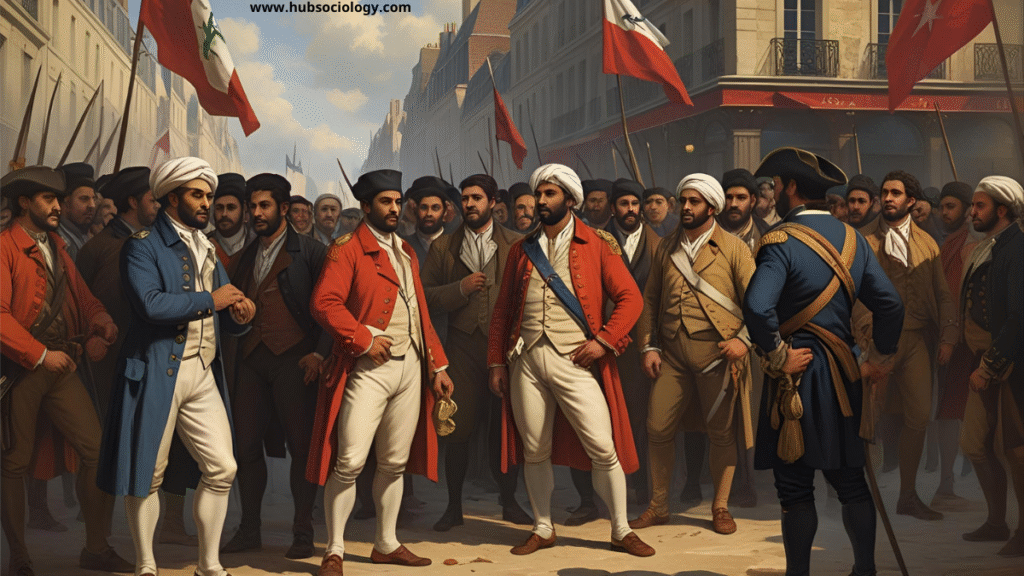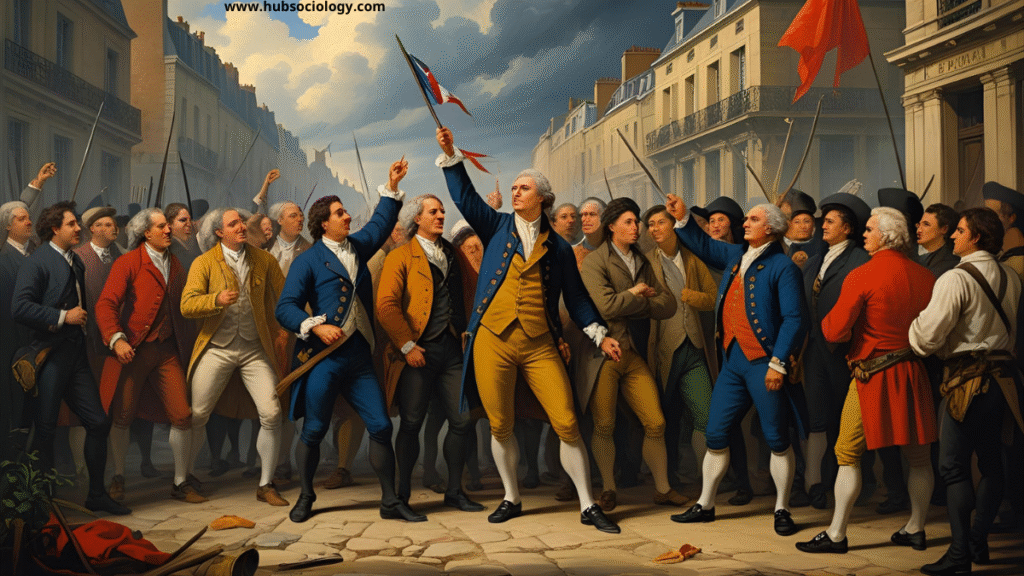Introduction
A turning point in modern history, the French Revolution (1789–1799) signaled the end of absolutist monarchy and the emergence of democratic principles. While historians often focus on its political and economic dimensions, a sociological analysis reveals deeper insights into how social structures, class conflicts, and collective behavior shaped this transformative event.
From a sociological standpoint, the French Revolution was not merely a political upheaval but a radical restructuring of social hierarchies, norms, and institutions. This article examines the revolution through the lens of sociology, exploring themes such as social stratification, collective action, ideological mobilization, and the role of institutions in societal change.

1. Social Stratification and the Ancien Régime
The Three Estates: A Rigid Class System
Pre-revolutionary France was characterized by the Ancien Régime, a feudal system divided into three estates:
- The First Estate (Clergy) – Owned 10% of land, exempt from taxes.
- The Second Estate (Nobility) – Tax exemptions & feudal dues were among the several benefits enjoyed.
- The Third Estate (Commoners) – The Third Estate, or Commoners, is made up of 98% of the populace and is subject to high taxes. This group includes urban workers, bourgeoisie, and peasants.
This rigid stratification created deep-seated resentment. Despite their economic success, the middle class, or bourgeoisie, lacked political clout, which fueled calls for equality.
Marxist Interpretation: Class Struggle
Karl Marx later analyzed the revolution as a bourgeois revolution, where the rising capitalist class overthrew feudal aristocracy to establish a capitalist society. Marx’s conception of class struggle—a fight between the oppressors (nobility and clergy) and the oppressed (proletariat and bourgeoisie)—is consistent with the Third Estate’s uprising against feudal privileges.
2. Economic Inequality and Social Unrest
Fiscal Crisis and Peasant Suffering
France’s financial crisis, exacerbated by wars (e.g., the American Revolution) and extravagant royal spending, led to increased taxation on the Third Estate. Poor harvests (1788–1789) caused food shortages, sparking bread riots—a classic example of resource mobilization theory, where economic deprivation fuels collective action.
The Bourgeoisie as Agents of Change
The bourgeoisie, influenced by Enlightenment ideas (liberty, equality, fraternity), became key revolutionaries. Their ability to mobilize masses through pamphlets (e.g., Abbé Sieyès’ “What is the Third Estate?”) exemplifies cultural hegemony—where dominant groups shape ideologies to legitimize change.
3. Collective Action and Revolutionary Mobilization
The Storming of the Bastille: Symbolic Resistance
On July 14, 1789, the Bastille, a symbol of kingly oppression, was overrun by Parisians. This event illustrates relative deprivation theory—when people perceive a gap between their expected and actual conditions, they revolt. The mob’s actions also reflect emergent norm theory, where spontaneous collective behavior arises from shared grievances.
The Great Fear and Peasant Revolts
Rumors of aristocratic conspiracies triggered The Great Fear (1789), leading peasants to attack feudal manors. This mass hysteria highlights contagion theory, where emotions spread rapidly in crowds, leading to irrational but impactful actions.

4. Ideological Shifts and the Role of Enlightenment
Enlightenment Ideas as Catalysts
Philosophers like Rousseau, Voltaire, and Montesquieu critiqued absolutism, advocating democracy, separation of powers, and social contracts. Their ideas provided ideological fuel, demonstrating how cultural capital (knowledge and ideas) can drive social movements.
Secularization and the Decline of Church Power
The revolution dismantled the Church’s dominance, confiscating its lands and establishing a secular state. This aligns with Max Weber’s rationalization theory, where societies move from religious to secular-rational authority.
5. Revolutionary Institutions and Social Reconstruction
The National Assembly and Constitutional Reforms
The Declaration of the Rights of Man and Citizen (1789) abolished feudal privileges, establishing legal equality. This reflects structural functionalism—where institutions evolve to maintain social order.
The Reign of Terror: Radical Social Engineering
The Jacobins, led by Robespierre, used terror to eliminate counter-revolutionaries. From a sociological perspective, this exemplifies Durkheim’s anomie—a breakdown of norms leading to extreme measures in times of upheaval.
6. Gender and Social Change: The Role of Women
Women’s March on Versailles (1789)
The king was forced to return to Paris in October 1789 after hundreds of women marched to Versailles demanding bread. This highlights feminist sociology, showing how marginalized groups mobilize for rights.
Olympe de Gouges and Feminist Thought
De Gouges’ “Declaration of the Rights of Woman and the Female Citizen” (1791) challenged patriarchal norms, illustrating how revolutions often exclude women despite their participation.
7. Legacy: The Revolution’s Impact on Modern Society
Rise of Nationalism and Citizenship
The revolution introduced civic nationalism, where identity was based on citizenship rather than birthright. This influenced later movements, including anti-colonial struggles.
Sociological Theories Revisited
- Conflict Theory (Marx): According to Marx’s conflict theory, the revolution was a struggle between classes.
- Functionalism (Durkheim): It restructured society to adapt to modern demands.
- Symbolic Interactionism: Symbols (e.g., the guillotine, tricolor flag) shaped revolutionary identity.
Conclusion
In addition to being a political upheaval, the French Revolution was a major societal change. It dismantled feudal hierarchies, redefined citizenship, and demonstrated how collective action, ideology, and institutional change can reshape societies. From class struggles to gender dynamics, its lessons remain relevant in understanding modern revolutions and social movements.

By examining the revolution through sociological theories—Marxist conflict, Durkheimian anomie, Weberian rationalization—we gain deeper insights into how societies evolve under pressure. The French Revolution remains a pivotal case study in the interplay between structure, agency, and revolutionary change.
Topic related question
5-Mark Questions (Short Answer)
- How did the rigid social structure of the Ancien Régime contribute to the French Revolution?
- Explain the role of the bourgeoisie in the French Revolution from a Marxist perspective.
- What was the significance of the Storming of the Bastille in terms of collective behavior?
- How did Enlightenment ideas influence the French Revolution sociologically?
- Briefly discuss the concept of “relative deprivation” in the context of peasant revolts during the French Revolution.
10-Mark Questions (Detailed Answer)
- Analyze the French Revolution using Karl Marx’s theory of class struggle.
(Discuss feudal oppression, bourgeoisie rise, and proletariat unrest.) - How did economic inequality and fiscal crisis act as catalysts for the French Revolution?
(Include taxation, food shortages, and the role of the Third Estate.) - Examine the role of collective action and mass mobilization in the French Revolution, with reference to the Great Fear and Women’s March on Versailles.
(Apply theories like contagion theory and emergent norm theory.) - Discuss the impact of the French Revolution on the secularization of French society.
(Refer to the decline of Church power and the rise of rational-legal authority.) - How did the Reign of Terror reflect Durkheim’s concept of anomie?
(Explain breakdown of norms, extreme measures, and revolutionary justice.)
15-Mark Questions (Essay-Type)
- “The French Revolution was a bourgeois revolution.” Critically examine this statement from a sociological perspective.
(Discuss Marxist interpretation, class conflict, and the rise of capitalist ideals.) - Evaluate the role of ideology and cultural hegemony in shaping the French Revolution.
(Include Enlightenment ideas, pamphlets, and the construction of revolutionary symbols.) - How did the French Revolution challenge traditional gender roles, and why did feminist demands remain largely unfulfilled?
(Discuss Olympe de Gouges, women’s participation, and post-revolution backlash.) - Compare and contrast the functionalist and conflict theory perspectives on the French Revolution.
(Durkheim’s view on social order vs. Marx’s emphasis on class struggle.) - “The French Revolution was not just a political change but a complete social transformation.” Justify this statement with sociological arguments.
(Cover class restructuring, institutional reforms, and cultural shifts.)
